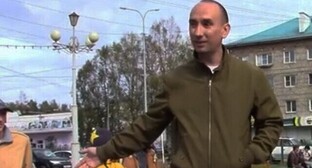07 September 2003, 20:05
Kuban Cossack Host
Part of the Cossacks in pre-revolutionary Russia, quartered in the Kuban region/oblast (the present-day Krasnodar territory and part of the Stavropol territory) with the center in Ekaterinodar (present-day Krasnodar). It was formed in 1860 of the Black Sea Cossack Host and part of the Caucasus "line" Cossack Host, comprising 22 (later up to 27) mounted regiments, 3 squadrons, 13 foot battalions, and 5 batteries. The Kuban Cossack Host took part in all of the wars Russia waged in the second half of the XIX through early XX cent. In 1914, it included 11 mounted regiments and 1 division, 2.5 guard sotnias (squadrons of 100 men), 6 "plastun" (foot) battalions, 5 batteries, 12 crews and 1 irregular sotnia (overall up to 19,000 men). During 1914-18 World War I, the Kuban Cossack Host put forward 37 mounted regiments and 1 division, 2.5 guard sotnias, 22 plastun battalions, 6 batteries (12 in 1917), 49 various squadrons of 100 and 50 men, and 12 crews (a total of c. 90,000 men).
The Kuban Cossack Host consisted of two principal parts: the so-called "line Cossacks," mostly descendants of the Don Cossacks resettled to the Kuban area in the late XVIII cent. and quartered in the east of the region (the Caucasus, Labinsk, Maykop, and Batalpashinsk sections); and "Black Sea Cossacks," descendants of the Zaporozhye/Zaporizhzhya Cossacks resettled in the 1790s along the Kuban River from its mouth to the Laba River (the Yeisk, Ekaterinodar, and Temriuk sections). In the first half of the XIX cent., resettled to the Kuban area were Yekaterinoslav, Azov, Chernihiv/Chernigov, Poltava, and Danube Cossacks, as well as state serfs, "kantonists/cantonists" (a class in pre-revolutionary Russia; a kantonist is a soldier's son liable for military service - trans.), and retired soldiers enlisted as Cossacks. The regional population numbered 2.89 million (1916), including 1.37 million Cossacks (43%). Cossack lands totaled c. 7.412 million hectares; an allotment per head averaged 9 dessiatines (9.81 hectares). Significant development of capitalism led to deeper gaps between the Kuban Cossacks, which grew even more profound in light of the impoverishment of some Cossacks because of the service load. The poorer Cossacks accounted for about half of the Cossack population; their land allotments actually amounted to 2-3 dessiatines (2.18-3.27 hectares) per head. This, as well as enmity between the population of the better-off western and poorer eastern areas determined intense class antagonisms inside the Kuban Cossacks, which was aggravated by fighting the "foreign" (peasants and other non-Cossacks that resettled to Cossack lands after the abolishment of serfdom; they bought or rented land from Cossacks and worked as farm hands - trans.) who rented Cossack lands. There were rebellions in a series of plastun battalions and the 2nd Urup regiment during the 1905-07 revolution. The poorer Cossacks sided with the Soviet government after the 1917 October revolution, whereas the majority of the Cossacks headed by the 1917-20 Kuban Rada opposed it and supported General A.I. Denikin's Voluntary Army. In 1919, the Kuban corps commanded by Generals A.G. Shkuro and S.G. Ulagay actively fought the Red Army. However, Denikin's absolutist policy caused opposition among the Kuban Cossacks who sought autonomy.
The host was abolished in 1920. Kuban Cossack units were created in the Red Army in 1920-30. During the 1941-45 Great Patriotic War, Kuban Cossack divisions, particularly the 4th Kuban Cossack guard corps commanded by General N.Ya. Kirichenko, heroically fought for the Soviet homeland.
The Kuban Cossack Host has been restored presently. Kuban Cossacks have taken an active part in the Transnistrian and Abkhaz conflicts and wars in former Yugoslavia.




